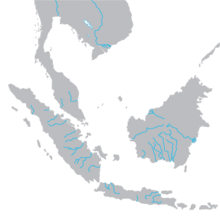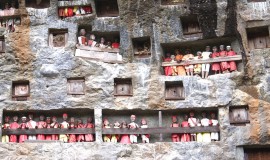Indonesia Culture and History
Culture
Indonesia has about 300 ethnic groups, each with cultural identities developed over centuries, and influenced by Indian, Arabic, Chinese, and European sources. Traditional Javanese and Balinese dances, for example, contain aspects of Hindu culture and mythology, as do
wayang kulit (shadow puppet) performances. Textiles such as batik, ikat, ulos and songket are created across Indonesia in styles that vary by region. The Indonesian film industry'spopularity peaked in the 1980s and dominated cinemas in Indonesia, although it declined significantly in the early 1990s. Between 2000 and 2005, the number of Indonesian films released each year has steadily increased. Indonesia holds 6 items UNESCO's Intangible Cultural Heritage
History
Pre-historical era
Fossils and the remains of tools show that the Indonesian archipelago was inhabited by
Homo erectus, popularly known as "Java Man", between 1.5 million years ago and as recently as 35,000 years ago.
Homo sapiens reached the region by around 45,000 years ago. In 2011 evidence was uncovered in neighbouring East Timor showing that 42,000 years ago these early settlers were catching and consuming large numbers of big deep sea fish such as tuna, and that they had the technology needed to make ocean crossings to reach Australia and other islands.
Austronesian peoples, who form the majority of the modern population, migrated to South East Asia from Taiwan. They arrived in Indonesia around 2000 BCE, and as they spread through the archipelago, pushed the indigenous Melanesian peoples to the far eastern regions. Ideal agricultural conditions, and the mastering of wet-field rice cultivation as early as the 8th century BCE,
allowed villages, towns, and small kingdoms to flourish by the 1st century CE. Indonesia's strategic sea-lane position fostered inter-island and international trade, including links with Indian kingdoms and China, which were established several centuries BCE. Trade has since fundamentally shaped Indonesian history. In the mid first millennium A.D, Indonesian trader ships to Madagascar as well as eastern coast of Africa.
Hindu and Buddhist kingdoms era

Expansion of Srivijayan empire, started in Palembang in 7th century, expanding throughout Sumatra, Malay Peninsula, Java, Cambodia, and receded as Dharmasraya in the 13th century.
Hinduism and Mahayana Buddhism arrived in Indonesia in the 4th and 5th century, as trade with India intensified under the southern Indian Pallava dynasty. This is evidenced in the Kutai, Tarumanagara, and Kantoli kingdoms of the period. From the 7th century to early 11th, the powerful Srivijaya naval kingdom become a hegemon in Southeast Asia and flourished as a result of trade and the influences of Hinduism and Buddhism that were imported with it. Srivijaya's main foreign interest was nurturing lucrative trade agreements with China which continued from the Tang dynasty to the Song dynasty. Srivijaya had religious, cultural and trade links with the Buddhist Pala Empire of Bengal, as well as with the Islamic Caliphate in the Middle East. The necessity to maintain its trade monopoly had led the empire to launch naval military expeditions against rival ports in Southeast Asia and to absorb them into Srivijaya's sphere of influence. The port of Malayu in Jambi, Kota Kapur in Bangka island, Tarumanagara and the port of Sunda in West Java, Kalingga in Central Java, the port of Kedah and Chaiya in Malay peninsula are among the regional ports that were absorbed within Srivijayan sphere of influence. A series of Javan-Srivijaya raids on the ports of Champa and Cambodia was also part of its effort to maintain its monopoly in the region by sacking its rival ports. After the invasion by Rajendra Chola I the king of the Chola Empire from Koromandel, authority of Srivijaya over the islands of Sumatera and the Malay Peninsula weakened. Some time later came a new dynasty that took over the role of Sailendra Dynasty, called by the name of Mauli dynasty. Mauli dynasty of Malay kings that rules Dharmasraya kingdom, centred in Batanghari river system. In later period of the kingdom's capital shifted inland upstream of Batanghari to Dharmasraya and later moved further inland toPagaruyung.
Between the 8th and 10th centuries, the agricultural Buddhist Sailendra and Hindu Mataram dynasties thrived and declined in inland Java, leaving grand religious monuments such as Sailendra's Borobudur and Mataram's Prambanan. The Hindu Majapahit kingdom was founded in eastern Java in the late 13th century, and under Gajah Mada, its influence stretched over much of Indonesia. The founder of the Majapahit, Kertarajasa, was the son-in-law of the ruler of the Singhasari kingdom, also based in Java. After Singhasari drove Srivijaya out of Java in 1290, the rising power of Singhasari came to the attention of Kublai Khanin China and he sent emissaries demanding tribute. Kertanagara, ruler of the Singhasari kingdom, refused to pay tribute and the Khan sent a punitive expedition which arrived off the coast of Java in 1293. By that time, a rebel from Kediri, Jayakatwang, had killed Kertanagara. The Majapahit founder allied himself with the Mongols against Jayakatwang and, once the Singhasari kingdom was destroyed, turned and forced his Mongol allies to withdraw in confusion. After its peak in the 14th century, Majapahit power began to decline and was unable to control the rising power of the Sultanate of Malacca. Dates for the end of the Majapahit kingdom range from 1478 to 1520. A large number of courtiers, artisans, priests, and members of the royal family moved east to the island of
Bali at the end of Majapahit power.















